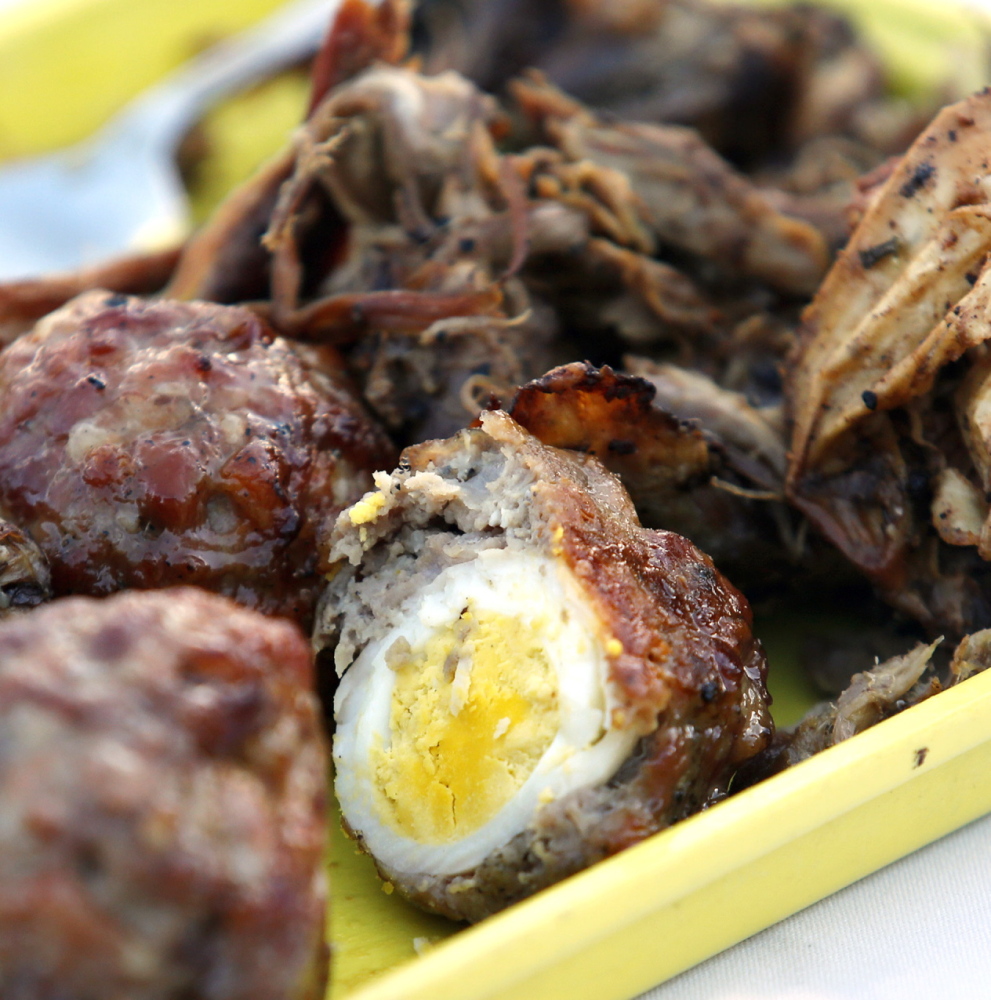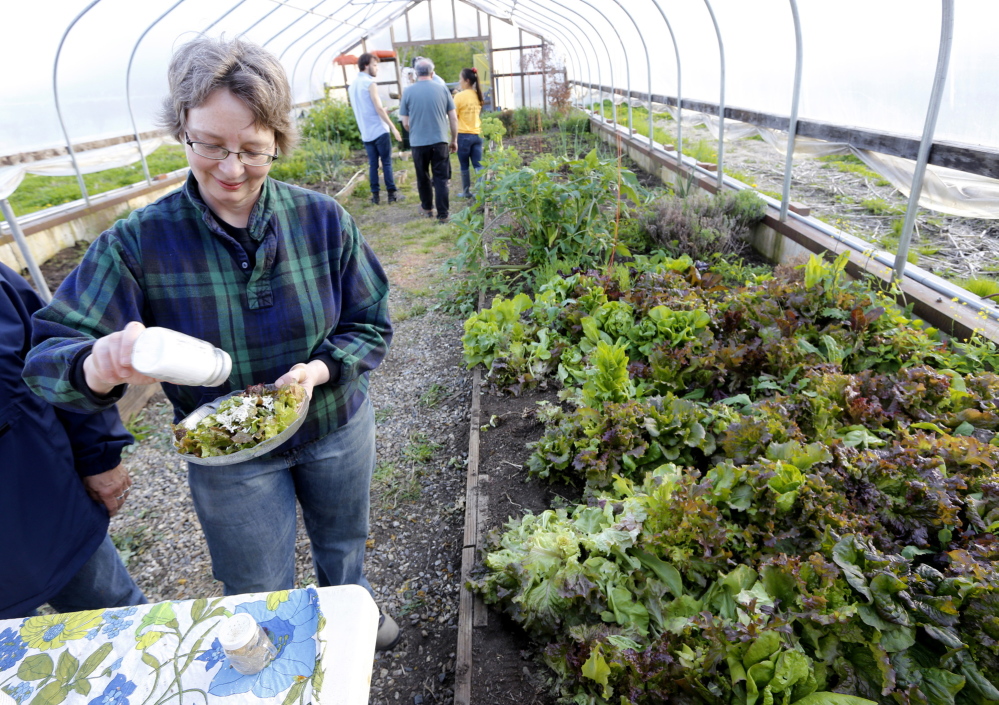TURNER — Penelope Ganske – wearing jeans, muck boots and a yellow T-shirt advertising Nezinscot Farm – walked her guests from the farm’s beehives to the herb garden, where a goat cheese and pesto appetizer awaited them.
This Bates College freshman from Cleveland, her thick blond hair hog-tied by a pigtail and red bandana, was clearly getting a kick out of talking about the five weeks she just spent on the farm. “Holding the newborn baby goats and seeing a goat born, that was incredible,” she said. “Within 30 minutes they’re walking. In 30 minutes. I saw one walk within 10.”
Ganske’s interaction with her guests at Nezinscot was part of an experience called a “performative dinner,” a place where food meets performance art. After the tour last week, 55 guests took their seats at a long outdoor table for a dinner that marked the culmination of a Bates short course called Food Culture and Performance. In past events, students have incorporated theatrical elements into the dinners; this one was focused on the experience of the space itself.
At the start, a student rang a bell and read a quote adapted from French philosopher Jacques Derrida’s “Of Hospitality”:
“Absolute hospitality requires that I open up my home and that I give not only to the foreigner but to the absolute, unknown, anonymous other, and that I give place to them and take place in the place I offer them, without asking of them either reciprocity or even their names.”
A moment of silence followed, to give thanks for the dinner the students had prepared, using only ingredients they found on the farm.
There were platters of roast lamb the students slaughtered themselves, buttery potatoes still warm from the farm’s wood-fired turtle oven, and jars of dandelion wine made with the same flowers some students now wore tucked behind their ears.
The Bates course is led by Myron Beasley, an associate professor of American Cultural Studies and African American Studies. “We look at food as a way of unraveling a lot of social and political issues,” he said.
The first year Beasley modeled the class on the Work Progress Administration’s “America Eats” program, where artists, writers and filmmakers were dispatched around the country to take a look at what America was eating in the 1930s. He called the Maine version “Savoring Androscoggin County” and sent students out to work with social workers and farmers.
The students read and talked about hunger in Maine. One group went to a park in downtown Lewiston every day and just asked people, “What did you have for breakfast?”
“That was an amazing moment for them,” Beasley said. “This person said all they had was spaghetti because that’s all they could afford. So just asking random strangers in a park what they had for breakfast provided a huge insight into notions of hunger, poverty and foodways.”
That course ended in a dinner held in an old mill.
The second course examined food and the sacred. The students spent time at sacred spaces, including two synagogues, and studied halal dietary laws as an example of how some people consider food sacred.
The third course at Nezinscot focused on the concept of hospitality and creating a meal based on the meaning of the word Nezinscot – “a place to gather.”
AFTERNOONS ON THE FARM
In the mornings, the students met in the classroom and talked about food-related topics, food culture and where their food comes from. Afternoons were spent on the farm with owners Gloria and Gregg Varney and their five children. They did barn chores, fed the animals, milked goats, made cheese, planted vegetables, baked bread, churned butter and learned how to felt.
Many of the students, especially the ones from larger cities, had never been on a farm. “I’m from New York,” said Harrison Brown, chatting with guests. “I’ve never experienced anything like this.” (Beasley later noted that, while Brown was wary of the farm’s pigs at first, he grew to love feeding them.)
Others, especially the first-year students, came to the class already interested in food politics. Some had even worked on a farm before.
For Alexa Adams, a freshman from Williamstown, Massachusetts, visiting the farm was a welcome respite from her anthropology coursework and pre-med requirements.
Usually her days are filled with repetition and time spent working on problems. At the farm, she fed the goats, watered the horses and made sure all the animals in the barn had hay. She lugged goat’s milk to the kitchen, where it would be made into cheese and yogurt.
“I’ve never made cheese, and I’ve never milked goats before,” Adams said. “It’s been kind of cool to jump into something and learn as you go.”
Adams was one of several students who slept over in the barn to wake up with the animals. Staying over also meant being able to observe the evening chores and life on the farm.
“The family all sits down together for dinner, and you can eat all the food that you’ve been working on during the day,” Adams said.
She also was there for the slaughter of the lamb and turkey that would become part of the performative dinner.
“We were able to see the animals grow up, saw them in their natural environment, fed them, hung out with them and then eventually thanked them for their lives and got to see the whole process until they were on your plate,” she said. “We did it in the most humane way possible. They didn’t really have any pain, which was nice to see. And if I were an animal, I would much rather be raised in a place like this, having a great life and all of this space rather than being cooped up in a small cage.”
Beasley said he was surprised to find that most of the women students signed up to watch the slaughter. (“The boys were into baking.”) While they were trepidatious at first, by the time Gloria Varney opened up the lamb’s carcass, fear had turned into fascination.
“She opened the chest,” Beasley said, “and all the innards came out, and the kids were just …” He leaned forward and made a whoosh sound.
Varney recalled talking to the students about why she wanted them to be present for the slaughter.
“I want to create a different memory of an animal’s death, an animal’s life, and that watching the birth of a baby goat is just as emotional as watching the death of an animal,” she said. “After we had that conversation, they all came closer. I just kept going without talking and processed it and was skinning it off, and half an hour into it I said to them, ‘How do you feel now?’ They said, ‘It doesn’t feel so bad now, because we first took a moment and thanked this animal for its life.’ ”
Later, they went into the kitchen, sautéed the lamb’s heart and liver in butter, and ate them.
DINNER IS SERVED
Before settling down for dinner, the students led guests through a tour of the farm, stopping along the way to pick herbs in the medicinal garden, to hear the story behind the wood-fired oven, to taste honey fresh from the beehives and kale pesto from the herb garden, and to make their own salads. Then everyone took their place at a long table set with candles and bars of goat’s milk soap made by the students. Handmade felt orbs hung alongside strings of lights.
Jars of dandelion wine and blood orange shrub were set out for drinking.
Dinner consisted of roast turkey and lamb, carrots, potatoes, fresh baked bread with chive butter, and Scotch eggs, hard-boiled and wrapped in sausage.
One student shared the history of the farm. Another talked about what family gatherings are like in her Greek family. Two students played violin and guitar and led the group in a song.
The students asked the guests if they had “a story about gathering” they would like to share, prompting one Bates professor to tell a funny story about a Thanksgiving dinner she hosted in Ireland. Another guest shared the story of his wedding day.
The evening ended at the farm’s little tea house.
Christina Bell, a librarian at Bates and a guest at the dinner, said she hadn’t known what to expect. She’s visited Nezinscot Farm many times, but after walking the grounds thinking about the process of growing food and the performative dinner she said, “I’m seeing it in a whole new way.”
“Every place we visited in some way contributed to this food that we’re eating,” Bell said. “It’s certainly, I would say, a performative experience. That’s a good description.”
Varney, who exudes an earthy den mother vibe toward the students, said she anticipates doing more with Bates and other colleges to educate young people about farming and food.
The events to come may look quite different from this dinner – they may be cooking classes or baking seminars or lessons in animal husbandry – but they will all have the same purpose.
“What I told these kids was, ‘You may not be farmers, but in order for me to be able to be a farmer, I need support and a better understanding from those of you who are out there buying food,’ ” she said. “I want to give them a better visual of what it’s all about to produce food and where their food is coming from.”
From Beasley’s perspective, the class not only taught his students about where food comes from, it helped them understand the meaning behind a big theme that runs through a Bates education: “What is a purposeful life?”
Days on the farm showed the students some possible answers to that question and introduced them to a lifestyle that is not dependent on consumption or making a lot of money, Beasley said.
The Varneys “are doing what they love,” he said. They’re both college-educated people, and this was a choice that they made to do what they really love, so they’re living a life of purpose. It was really important for my students to see that.”
Staff Writer Meredith Goad can be contacted at 791-6332 or at mgoad@pressherald.commgoad@pressherald.com
Twitter: MeredithGoadMeredithGoad
Send questions/comments to the editors.








Comments are no longer available on this story